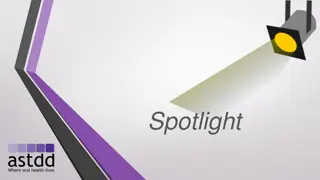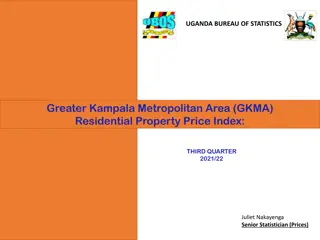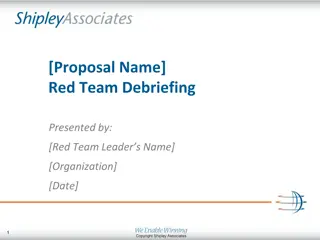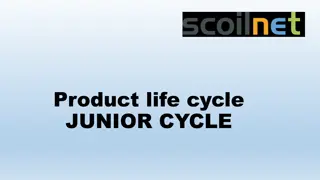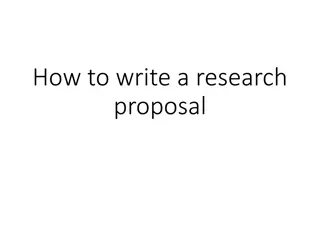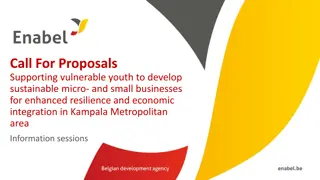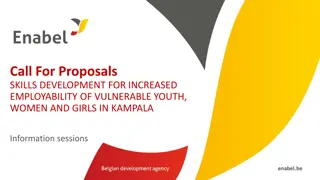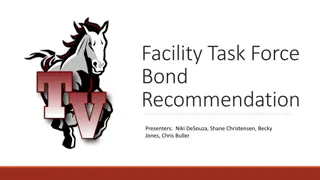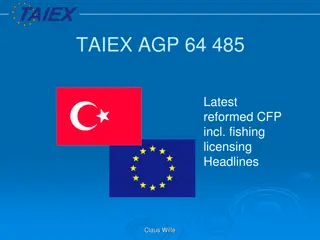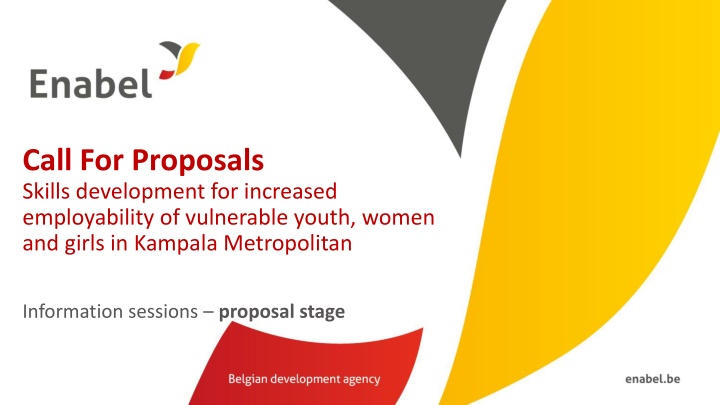
Skills Development Call for Increased Employability in Kampala Metropolitan
"Join the information sessions for a proposal stage focusing on skills development to enhance the employability of vulnerable youth, women, and girls in Kampala Metropolitan. Get insights on the selection process, proposal templates, M&E frameworks, and application procedures for this important initiative."
Download Presentation

Please find below an Image/Link to download the presentation.
The content on the website is provided AS IS for your information and personal use only. It may not be sold, licensed, or shared on other websites without obtaining consent from the author. If you encounter any issues during the download, it is possible that the publisher has removed the file from their server.
You are allowed to download the files provided on this website for personal or commercial use, subject to the condition that they are used lawfully. All files are the property of their respective owners.
The content on the website is provided AS IS for your information and personal use only. It may not be sold, licensed, or shared on other websites without obtaining consent from the author.
E N D
Presentation Transcript
Call For Proposals Skills development for increased employability of vulnerable youth, women and girls in Kampala Metropolitan Information sessions proposal stage
Presentation Presentation outline outline 1. Introduction & objectives (Emmanuel) 2. Selection process summary and promoted strategies (Joannah) 3. Proposal template a) Annex A; part B, proposal (Jan) b) M&E logical framework, Indicators (Adam/Evaline) c) Discussion on budgeting (Budget template) (MacMillan) 4. Application procedure/next steps (Joannah)
1. Objective of the proposal orientation meeting Share common missing or wrong elements in the Concept Notes in the previous stage (General feedback) Information on the process and tools for full proposal development: templates, procedures, timelines relevant for phase 2 Respond to any questions and concerns regarding the CfP
1. Objectives of the call Guidelines, annexes, clarifications (Q&A) and all other communication: https://www.enabel.be/grants/ Call reference number: UGA22003-10008 Call Title: SKILLS EMPLOYABILITY OF WOMEN AND GIRLS IN KAMPALA METROPOLITAN AREA DEVELOPMENT VULNERABLE FOR INCREASED REFUGEES, YOUTH,
1. Introduction & objectives - RECAP of the CfPs 1. Call Objectives 1. Call Objectives General objective The livelihoods of vulnerable youth are improved through enhanced access to quality, demand-driven skills development and employment support services Specific objective The provision of skills development is more equitable, qualitative, innovative, and labour market-driven for increased employment opportunities
1. Introduction & objectives - RECAP of the CfPs 1. Call objectives 1. Call objectives Partnerships between training providers and private sector actors in skills development are promoted 2000 vulnerable youth are equipped with quality, labour market relevant skills 2000 vulnerable youth have enhanced access to wage and s elf-employment through post-training support services Good practices in skills development are identified, documented and supported to scale up
1. Call Objectives Target groups: Vulnerable youth who are low or non-skilled and face barriers to access employment and socio-economic integration and residing in the eligible districts and city authorities Vulnerable = (a combination of) different categories of youth: Urban refugees (registered as refugees by OPM/UNHCR) Young women Youth with disabilities / chronic diseases Youth in poverty Youth not in employment, education or training
2. CN (stage 1) selection process Deadline for submission was 5thSeptember 2024 74 concepts were received on the submit website 39 passed admissibility check and qualified for technical evaluation 16 scored min 30/50 (and 6/10 on Q12). 13 shortlisted concept notes invited for 2ndstage (absorbing 300% of total call volume)
2. Concept note selection process summary 2. Evaluation - Concept note vs Proposals Focus CN RELEVANCE of proposed action Focus Proposals RELEVANCE of proposed methodology/strategic approaches EFFECTIVENESS & FEASIBILITY CAPACITY/EXPERIENCE
2. Concept note selection process summary 2. Content - Concept note vs Proposals No substantial changes to the initial CN (e.g. changes to lot, districts, co-applicant) Requested contribution cannot vary more than 20% from initial estimate + must remain between the min and max that can be requested (150,000 500,000 EUR)
2. Promoted strategies Mandatory activities: Labour market analysis Social inclusion strategies: PWDs, breast feeding mothers, selection criteria, etc. Training between 6 and 9 months with minimum 30% WBL Soft skills for enhanced employability Assessment and certification (DIT/national/international certification) Integration of OSH standards and measures (materials + protective wear)
2. Promoted strategies Engagement employability and employment prospects Provision of relevant start-up kits and/or micro business grants Minimum 6 months extensive and innovative post-training employment support/business startup support services of private sector in all stages to enhance
3. Proposal template a) Annex A; part B proposal 3a. Annex A; part B proposal Detailed description of the action & methodology 6 sections (description, strategic approach, methodology (who/what/when/how), action plan, risks & assumption, sustainability) log frame budget Administrative data and information for lead and co-applicant(s) The lead applicant s experience for similar and other actions Capacity to manage and perform actions (experience in the sectors) Resources (financial data, source of financing, number of people employed) The co-applicant(s) experience for similar and other actions History of cooperation with lead applicant Capacity to manage and implement actions (experience in the sectors) The associates (if any) - participate actively in the action, but are not eligible for grants and only qualify to receive daily allowances and travelling expenses) Mandate for each co-applicant and associates signed Declaration for lead applicant signed *any sub-grants must be indicated under methodology
! Attention points ! Detail/elaborate approaches/methodology to engage private sector throughout the program (e.g., training curriculum development, training, WBL, post-training support). How will they be involved, incentivised and monitored? How will quality assurance aspects be ensured? Clarify clearly strategies to promote sustainability in post-training support - Distribution strategy of start-up kits, networks and linkages, etc. Clarify clearly strategies related to access to markets and finance Highlight social inclusion strategies throughout the program: recruitment, training, WBL and post-training support Ensure logical flow between activities (eg. training & WBL) & structuring between different phases (e.g., inception, baseline, implementation, end-line)
! Attention points ! Ensure 100% alignment of structure between narrative, activity plan, budget & logframe Incorporate technical aspects demonstrating the potential to contribute to sustainable adoption of good practices and contribute to environmental conservation Clarify clearly the role and complementarity of (and/or engagement with) each stakeholder in implementation: Applicant, co-applicant(s), any associate External stakeholders: community, local govt, private sector
! Attention points ! Provision of start-up kits and/or micro business grants, tailored to specific business needs or business plans developed by targeted youth (if applicable) Start-up kits maximum 15% of the budget to provide a strategy on how the kits will effectively promote sustainable business development and not distort the local ecosystem and market Micro business grants can only be rewarded to maximum 20% of the supported youth
RECAP of the CfPs 3a. Sub-grants RECAP (if applicable) Sub-granting to sub-recipients of sub-grants is allowed in the form of; I. Micro-business grants to graduates for investment/capital Sub- granting is optional not mandatory In application form, the following details should be clearly provided: 1. The description of the objectives and results to be achieved with these sub- grants, the fundamental principles, the key concepts, the mechanisms, the actors and their role in the management process; 2. The criteria and modalities for the allocation of grants, accessibility conditions sub-beneficiaries, conditions for the admissibility of sub-projects, eligibility conditions for activities, costs and expenses; 3. The procedures for examining and awarding applications; 4. The maximum amount that can be allocated by sub-beneficiary; 5. The terms of contractualization with the sub-beneficiary; 6. The procedures and modalities for disbursing resources; 7. The procedures and modalities for technical and financial monitoring; 8. The procedures and modalities of control.
RECAP of the CfPs 3a. Sub-grants RECAP (if applicable) I. Micro-business sub-grants conditions: The maximum amount for the sub-grants under this category is EUR 250 per supported youth/youth owned business; Maximum 20% of supported youth/youth-owned businesses under the action can be eligible for a micro business grant; To be eligible for a micro business grant, supported youth must have successfully completed the training organized under the action, be certified and present a sound and viable business plan/model; Approval of micro business grants for supported youth/youth-owned businesses will be done by a selection committee which is to include representatives of Enabel, and by applying different evaluation criteria including (but not limited to) the viability of the business plan/model, vision/sound projections, financial need and relevance, technical and economic feasibility, experience and motivation of the applicant, etc. Types of activities eligible for micro business grants include purchase of equipment, raw materials and inventory, marketing and advertising activities, or start-up related costs for newly developed businesses; The following costs are ineligible for sub-granting: non-business-related costs (e.g. personal expenses or assets) and repayment of existing debts or loans. Payment modalities cannot include any payment in cash.
3. Proposal template a) Annex A; part B proposal
3. Proposal template b) M&E, framework, indicators 3b. M&E logical framework, indicators Use Annex C: logframe template and explain logic
3. Proposal template b) M&E, framework, indicators Logical flow Planned work Intended results Assumptions Assumptions& & risks risks Resources/ Resources/inputs inputs Activities Activities Outputs Outputs Outcome Outcome Impact Impact Number trained, sensitized Products developed and shared Equipment distributed Short term Knowledge/skills acquired Attitudes changed Change in behaviour Decisions made Actions undertaken Long term Social change Economic change Environmental change ... Problem analysis Stakeholder analysis Objectives Risk analysis Staff Time Money Materials Equipment Technology ... Workshops Meetings Field trips Trainings Service delivery ... Participant is object Participant is subject
3. Proposal template b) M&E, framework, indicators
3. Proposal template b) M&E, framework, indicators 3b. Example Impact/GO IMPACT - The livelihoods of vulnerable youth, including young women, in Albertine and Rwenzori subregions, are improved and sustained through access to skills development 65% of the graduates are employed (self and/or wage employment) six months after the training Employment = at least UGX 214,000 for 3 consecutive months by the end of the action
3. Proposal template b) M&E, framework, indicators 3b. Example Outcome/SO OUTCOME 1- To equip 150 youth (50% female) with vocational and soft skills in selected trades by 2024 80% of the trainees are certified by DIT 80% of the trainees successfully complete the training OUTCOME 2 - To support the establishment of at least 5 new youth-led group businesses by 2024 70% of the graduates utilising the startup kits 6 month after graduation
3. Proposal template b) M&E, framework, indicators 3b. Example Output/results # trainees enrolled / trained # trainees completing training # trainees assessed by DIT # companies assessed for WBL # companies engaged for WBL # graduates linked to financial services
3c Proposal template budget The budget need to be coherent with the activities in the narrative & action plan NUMBERING: Activity 1 in the narrative planning need to be transferred to a budget line for activity 1 TIMING: if you plan activity 1 in quarter 1 only, then you will only foresee a budget in quarter 1 for that activity CODING: Codes correspond with the Logframe: Specific Objective, 01 Result number one,01 Activity Number one under result no One.A0101.3rd level relates to sub activities e.g A010101,A010102 Budget min 150,000 max 500,000 euro
3c. Proposal template - Budget On a daily basis you will work with UGX, but the official max grant amount is in euro which you cannot exceed, so follow up of execution in euro is needed. FX rate of UGX 3800: 1 EUR (grantees can use their own exchange rate (based on a reliable source) to estimate the budget Exchange rate losses are ineligible costs and should be covered by the grantees themselves (e.g. through structure costs). Additionally, since the purpose of the grant is not to make money, any gains (exchange or interest) made on the funds received from Enabel must be re-used for the activities after Enabel approval.
3c. Proposal template - Budget The budget is broken down in 3 cost components; 1. Operational costs (actual activity costs - general means cost): necessary and indispensable cost for achieving the objectives and results of the action, including the cost for achieving verifiable deliverables Ex : fees for instructors, consultancy fees, fuel for transporting, workshop costs, training materials, food for trainees, fees for trainees etc. 2. Management costs (costs to support the management team): identified costs related to management, supervision, coordination, monitoring, control, evaluation and financial audit which specifically originate in the implementation of the action or the justification of the Grant Ex : Salary for staff, Mid-term evaluation, special audit costs 3. Structure costs (7% max of eligible operational costs) costs related to the achievement of the social purpose of the beneficiary, which cannot be separated or charged to the budget of this action even though they are affected by the implementation of the action. They are a max of 7% of the eligible operational costs. Ex: supporting staff (those that cannot be justified under management costs through timesheets e.g., procurement), water & electricity & internet of the office etc.
3c. Proposal template - Budget What are the rules concerning structure costs? - The percentage (max.7%) must be justified before signature of the Grant Agreement and correspond to the general structure costs of the grantee - It s a lump-sum and maximum 7% of operational costs - Once the % has been set and confirmed by the analysis of the grantee s accounts, no supporting document have to be provided by the grantee. In the reporting, it just appears as a separate line at the end (+ 7%).
3c. Proposal template - Budget Ineligible costs (1/2): Expenses that are included in the ineligible list (see guidelines) Expenses that are incurred before or after the duration of this grant agreement Expenses that cannot be identified, verified and are not included in the grantee's accounts Expenses not in line with applicable legal fiscal and social provisions Expenses that are not reasonable, justified, not respecting the principle of good financial management, in particular concerning cost efficiency and effectiveness Expenses not in line with the action plan, not necessary to achieve the results No contributions in kind are considered
3c. Proposal template - Budget Ineligible costs (2/2): Accounting entries not leading to payments Provisions for liabilities and charges, losses, debts or possible future debts Debts and debit interests Doubtful debts Currency exchange losses Loans to third parties Guarantees and securities; Costs already financed by another grant Invoices made out by other organisations for goods and services already subsidized Subcontracting by means of service or consultancy contracts to personnel members, Board members or General Assembly members of the organisation subsidized Any sub-letting to oneself Purchases of land or buildings; Compensation for damage falling under the civil liability of the organisation Employment termination compensation for the term of notice not performed Purchase of alcoholic beverages, tobacco and derived products thereof
c) Proposal template - Budget Indicative Costs
3c. Proposal template budget DURING IMPLEMENTATION Modification between results leading to a variation not greater than 15% of amounts initially planned. Modification between activities of the same result leading to a variation not greater than 25% of the amounts initially planned. Changes between operational management costs (B) are not allowed without an amendment. Changes to structure costs (C) are not allowed. costs (A) and
3c. Proposal template budget Budget proposal may not differ more than 20% from the initial concept note budget and must remain within the minimum and maximum amounts Budget min 150,000 max 500,000 euro Budget presentation in excel (Annex B of the grant agreement)
4. Application procedure / Next steps 4. Application procedure / Next steps Use the complete Annex A Grant Application File, Part B. Do not use own templates & do not tweak the template Concept note may not be modified by the applicant in the proposal (no substantial change to key activities/approaches) Submission in English only Provide a detailed budget (annex B)- Amount requested in the proposal may not vary more than 20% in relation to the initial estimate Errors or major inconsistencies concerning the points mentioned in the instructions of the form may result in rejection (e.g., content required, pages, ) Enabel reserves the right to request clarification where the information provided does not enable it to carry out an objective evaluation
4. Application procedure / Next steps Submission Submission concept notes concept notes Deadline for application: 28/02/2025 at 5 PM EAT !!! Online submission form Submit : https://submit.link/3ji SUBMISSIONS BY EMAIL/POST AUTOMATIC REJECTION
4. Application procedure / Next steps Application Application procedure procedure REMAINING QUESTIONS: sdf.grants@enabel.be Subject: reference number + LOT Questions can be submitted until 7/02 Answers will be published on https://www.enabel.be/grants/ latest by 18/02
4. Application procedure / Next steps Application Application procedure procedure ! Primary source of information Guidelines, annexes, clarifications (Q&A) and all other communication & updates: https://www.enabel.be/grants/ SELECT UGANDA OPEN CALLS - FILTER REFERENCE NUMBER 22003-10008
4. Application procedure / Next steps Submission Submission proposal proposal Online submission form Submit : https://submit.link/3ji - Avoid last minute submission; System automatically closes when past deadline - Start working on a draft timely (you can always go back to your draft, it saves automatically) - Get documentation (annexes to the application file) ready on time; you cannot proceed to uploading application file before uploading the annexes)
4. Application procedure / Next steps NEXT STEPS NEXT STEPS January 21st, 2025 Invitations to submit the proposals NA February 7th, 2025 5:00 pm Deadline for clarification requests to the contracting authority February 18th, 2025 5:00 pm Response to clarification requests are given by the contracting authority February 28th, 2025 Deadline for the submission of the proposals 5:00 pm Opening, administrative checks and evaluation of proposals March 1st March 31st, 2025* NA April 1st, 2025* Request certificates and supporting documents relating to the grounds for exclusion (see 2.1.1 (2)) 5:00 pm April 7th 11th2025* Onsite organizational analysis of the successful applicants after technical evaluation NA April 15th, 2025* Receipt of certificates and supporting documents relating to the grounds for exclusion 5:00 pm Notification of the award decision and transmission of signed grant agreement April 25th, 2025* NA Signature of the Agreement by contracting beneficiary April 30th, 2025* NA
5. Next steps PART 2 Pre-selected applicants will be invited to submit time = 15 days Criminal record clearance (Interpol) certificate for the main authorized representatives of your organization (e.g. chairman of the board of directors AND the executive director) those that will sign the grant agreement Can take 2 weeks, ask timely!! Tax clearance certificate from Uganda Revenue Authority (URA) NSSF Clearance Certificate Documents cannot be older than 2 years
5. Next steps PART 2 Organisational assessments Assessment to confirm whether applicant has the capacity to implement the proposed activities. The purpose is to verify general characteristics, technical capacities, control environment, financial management, audit, procurements and context. Done by consultant & Enabel Visits of half a day to 1 day Can be organized on short notice be prepared



